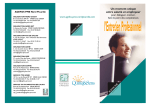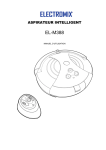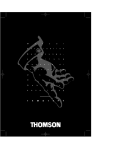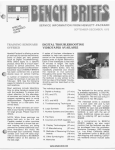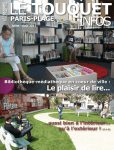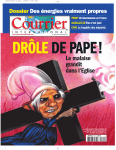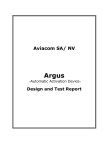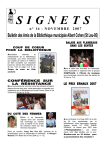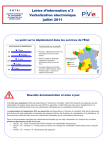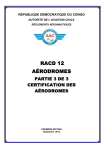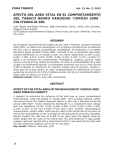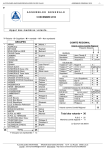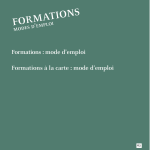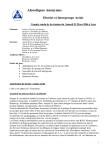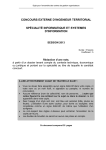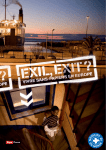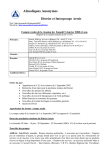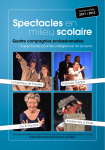Download Nord-Pas de Calais and LFQQ
Transcript
AVSIM Online - Flight Simulation's Number 1 Site!
AVSIM Commercial FSX Scenery Review
Nord-Pas de Calais & LFQQ
Product Information
Publishers: France VFR
Description: Photo real scenery of Nord-Pas de Calais en France including the airport of Lille
(LFQQ).
Download Size:
165 MB - LFQQ
4 GB - Nord-Pas de Calais
Format:
Download or DVD
Simulation Type:
FS9 / FSX
Reviewed by: Angelique van Campen AVSIM Senior Staff Reviewer - May 21, 2011
Introduction
You can see this review as a necessary preparation for my upcoming holiday. Via the Netherlands, Belgium and heading for Paris, you either go in a straight
line or via Lille. When heading via Lille, it automatically means you enter Nord-Pas de Calais. Although it’s mainly flat, it still has a charm to it and therefore
there’s no reason to compare it to the French Alps or Pyrenees. On my way to middle- and southern France, I’ve decided to drive “virtually” via Lille and see
what France VFR made of this French region.
http://www.avsim.com/pages/0511/FranceVFR1/PasDeCalais.html (1 of 17)21/05/2011 10:53:02 AM
AVSIM Online - Flight Simulation's Number 1 Site!
France VFR is known for their high quality photo-real French scenery and/or aircraft and let’s not forget their mesh scenery. But for the moment let’s stick to
this review title - photo-real scenery of the French region Nord-Pas de Calais and the airport of Lille Lesquin International Airport (LFQQ). I could
have a look at their French website, but they still offer this only in the French language. There is still no way to get it in English or German, but the supplied
manuals will help us to see what France VFR writes about these products. In fact, this FSX review covers not only the photo-real scenery of Nord-Pas de
Calais VFR, but also Lille Lesquin International Airport.
According to France VFR “The Nord-Pas de Calais VFR covers the French North region (about 15 000 sq. Km.) with photo realistic textures.
Each of the default airport platforms on the scenery have been reworked in order to closely fit the photo texture with precisely aligned taxiways, buildings
and objects, greatly enhancing them from those of the standard Flight Simulator X® fare. Many 3D objects and VFR landmarks are provided to experience
high quality VFR flying, and customized autogen coverage (houses, buildings and vegetation) is provided for the whole scenery. Therefore, the virtual pilot
can experience both VFR and IFR flights within a very large zone at a degree of realism never seen before in this region.
France VFR main goal in developing this new concept of scenery add-ons is to recreate a realistic flying experience from a pilot’s point of view. This scenery
is part of the VFR Régional collection that will provide at least one extension pack to enhance this base product with new objects, VFR landmarks, airports,
a larger autogen coverage and much more depending on the region.
Some technical features:
●
●
●
●
●
●
●
●
●
●
●
●
Zone of 15 000 sq. km. covering the French Britany region with photo realistic textures.
Textures made from aerial photography IGN (National Geographical Institute) and not satellite imagery are recreated for an optimal visual rendition in
Flight Simulator X.
Ground textures are summer only.
Very high resolution 4.75 meter (LOD13) optimized custom mesh is included.
New autogen 3D buildings models with custom autogen for the whole scenery.
All lakes and rivers have been entirely cut out and faithfully represented and reworked with bodies of landable water, including a systematic mesh
treatment of nearby banks in order to avoid sloping water effects.
Water transparency effects for the whole scenery coverage.
22 airports and airfields are integrated. These airports have been optimized to fit the photo scenery perfectly - precise taxiway and apron
positioning, replaced buildings and hangars, windsocks, towers, etc.
Semi-detailed airports buildings with night textures and extremely detailed harbor areas.
Many 3D objects and VFR landmarks (bridges, lighthouses, monuments, windmills…) and many objects with special effects.
Extremely precise geo-referenced texture positioning is carried out in order to ensure a maximal compatibility with scenery add-ons for this region.
Comprehensive maps and flight documentation available for the integrated airports and airfields (VAC VFR approaches and airport diagrams).
About Lille Lesquin International Airport (LFQQ) France VFR says “LFQQ represents an extremely detailed French Regional airport in the North of
France. It includes high-definition textures of ground and buildings as well as night textures. The scenery covers about 50 sqr.km and adds an extended
photo realistic area to the airport including specific autogen and VFR landmarks and nearby road traffic.
The scenery can be used as a standalone product or in addition to the Nord Pas de Calais scenery without any adaptation. Due to its particular concept, the
scenery is entirely compatible with any mesh of your choice.
LFQQ Lille Lesquin features:
●
●
●
●
●
●
●
Photo-real high definition ground and buildings textures including night textures.
Specific autogen included for the entire zone of 50km².
Road traffic included.
Numerous customized and generic 3D objects.
The Stand-alone product can be used on its own, or embedded in the Nord Pas de Calais VFR scenery without any modification.
Independent conception of Mesh (all Mesh are compatible).
Charts SIA – VAC – IAC – ARR/DEP are provided.”
I’m aware this is a lot of promotional text, but knowing France VFR already for a couple of years, I am confident about the outcome. Let’s move on. The next
http://www.avsim.com/pages/0511/FranceVFR1/PasDeCalais.html (2 of 17)21/05/2011 10:53:02 AM
AVSIM Online - Flight Simulation's Number 1 Site!
section covers some background information of the region Nord-Pas de Calais including LFQQ.
Real Nord-Pas de Calais and LFQQ
Nord-Pas-de-Calais or Nord-Pas de Calais, is one of the 27 regions of France. It consists of the departments of Nord and Pas-de-Calais, in the north and
has a border with Belgium. Most of the region was once part of the Southern Netherlands, within the Low Countries, and gradually became part of France
between 1477 and 1678. The historical provinces now included in Nord-Pas-de-Calais are Artois, Boulonnais, Calaisis, Cambraisis, French Flanders, French
Hainaut and portions of northern Picardy. These provincial designations are still frequently used by the inhabitants, which offer a sense of civic pride.
With its 323.7 people per km2 on just over 12,400 km2, it is a densely populated region, having some four million
inhabitants—seven percent of France's total population, making it the fourth most populous region in the country—83% of
whom live in urban communities. Its administrative center and largest city is Lille with the airport LFQQ. The second
largest city is Calais, which serves as a major continental economic/transportation hub with Dover of Great Britain 42
kilometers (26 miles) away; the White Cliffs of Dover are visible from Calais on a clear day. Other major towns include
Valenciennes, Lens, Douai, Béthune, Dunkirk, Maubeuge, Boulogne, Arras, Cambrai and Saint-Omer.
The name Nord-Pas-de-Calais combines the names of the constituent departments of Nord (literally 'North', the
northernmost department of France) and Pas-de-Calais ('Strait of Calais', the French name of the Strait of Dover). The
regional council, however, spells the name Nord-Pas de Calais.
The northern part of the region was historically a part of Flander's, with Douai as its capital. The minority who wish to show the historical links the region has
with Belgium and the Netherlands prefer to call this region the French Low Countries, which also means French Netherlands in French, Pays-Bas Français.
While the region is predominantly French-speaking, it also has two significant minority language communities: the western
Flemings, whose presence is evident in the many Dutch place names in the area and who speak French Flemish, a variety
of the West Flemish dialect of Dutch.
Nord-Pas-de-Calais became a major center of heavy industry in the 19th century with coal mines, steel mills and traditional
textile manufacture. It suffered badly in both World Wars and recovered less quickly than did other parts of France. In
recent years, it has experienced economic slumps as the mines closed, the steel industry declined and the textile industry
ran into problems. Between 1975 and 1984, the region lost over 130,000 jobs and unemployment rose to 14% of the
working population, well above the national average. The region has, however, benefited from major government and
European Union investment over the past 20 years.
The opening of the Channel Tunnel in 1994 was welcomed in the region as a means of boosting its economic future. Tourism, particularly in Lille at the apex
of the London-Brussels-Paris railway lines, has grown considerably, to the extent that in 2004, 7 million passengers used the Eurostar, as well as 2 million
vehicles on the Eurotunnel. In addition to the trains, in 2002, there were about 15 million passengers from the three major ferry ports of the region (Calais,
Dunkirk and Boulogne).
Lille is the principal city of the Lille Métropole, the fourth-largest metropolitan area in the country behind those of Paris, Lyon and Marseille. Lille is situated
on the Deûle River, near France's border with Belgium. It is the capital of the Nord-Pas de Calais region and the prefecture of the Nord department.
The city of Lille, which annexed Lomme on 27 February 2000, had a population of 226,014 at the 2006 census. Meanwhile, the Lille Métropole, which also
includes Roubaix, Tourcoing and numerous suburban communities, had a population of 1,091,438. The eurodistrict of Lille-Kortrijk, which also includes the
areas of the Belgian cities of Kortrijk, Tournai, Mouscron and Ypres, had 1,905,000 residents.
http://www.avsim.com/pages/0511/FranceVFR1/PasDeCalais.html (3 of 17)21/05/2011 10:53:02 AM
AVSIM Online - Flight Simulation's Number 1 Site!
In 1967, the Chambers of Commerce of Lille, Roubaix and Tourcoing were joined, and in 1969 the Communauté urbaine de Lille (Lille urban community) was
created, linking 87 communes with Lille.
Throughout the 1960s and 70s, the region was faced with some problems after the decline of the coal, mining and textile industries. From the start of the
1980s, the city began to turn itself more towards the service sector.
In 1983, the VAL, the world's first automated rapid transit underground network, was opened. In 1993, a high-speed TGV (Train à Grande Vitesse) train line
was opened, connecting Paris with Lille in one hour. This, with the opening of the Channel Tunnel in 1994 and the arrival of the Eurostar train, put Lille at
the center of a triangle connecting Paris, London and Brussels.
Work on Euralille, an urban remodeling project, began in 1991. The Euralille Centre was opened in 1994, and the remodeled district is now full of parks and
modern buildings containing offices, shops and apartments. In 1994 the "Grand Palais" was also opened.
Lille was elected European Capital of Culture in 2004, along with the Italian city of Genoa. A former major mechanical, food industry and textile
manufacturing centre as well as a retail and finance center, Lille forms the heart of a larger conurbation, regrouping Lille, Roubaix, Tourcoing and Villeneuve
d'Ascq, which is France's 4th-largest urban conglomeration with a 1999 population of over 1.1 million. Lille features an array of architectural styles with
various amounts of Flemish influence, including the use of brown and red brick. In addition, many residential neighborhoods, especially in Greater Lille,
consist of attached 2-3 story houses aligned in a row, with narrow gardens in the back. These architectural attributes, uncommon in France, help make Lille
a transition from France to neighboring Belgium, as well as nearby Netherlands and England, where the presence of brick, as well as row houses or the
Terraced house is much more prominent.
Points of interest include:
- Jardin botanique de la Faculté de Pharmacie
- Jardin botanique Nicolas Boulay
- Jardin des Plantes de Lille
- Citadel of Lille
Lille Lesquin International Airport (LFQQ) is 15 minutes from the city center of Lille. It is the 12th busiest French airport in number of passengers:
around 970,000 passengers in 2001 and 1,147,924 passengers in 2009. In terms of cargo, it ranks fourth, with almost 38,000 tons of freight which pass
through each year. Lille Airport – stands on over 450 hectares of land, containing 5 hectares of buildings.
Although its normal activity is carried out between 5am and 11pm, the airport is open to international traffic 24 hours a day.
It is equipped for VFR, night IFR and is classified ‘Category A’ (international), Category 7 SSLIA (Services de Sauvetage et de Lutte contre l’Incendie des
Aéronefs, which means free translated Service of Safeguard and Fight against Airplane Fire). Lille Airport can accommodate all types of aircraft, from a
single engine private aircraft to the large commercial carriers (A380) or Cargo aircraft (Antonov 124).
I’m aware that this section offers you a lot of background information about Nord-Pas de Calais and its only international airport, but still worth offering you
the information. Now it’s time to move on to the France VFR products and see how real they are.
Installation, FSX configuration and documentation
The installation procedures of both France VFR products are more or less the same, with the exception that NordPas de Calais consists of two installers. After you’ve entered the registration code, the installers find their own
way. This means auto detection of Microsoft Flight Simulator X folder. Once Nord-Pas de Calais part I is finished,
you close the installer as usual and restart the 2nd Nord-Pas de Calais installation, however, this time there’s no
need to enter the registration code again.
It may look like Lille Lesquin Airport is a part of the France VFR scenery, however this is not the case. If you
http://www.avsim.com/pages/0511/FranceVFR1/PasDeCalais.html (4 of 17)21/05/2011 10:53:02 AM
AVSIM Online - Flight Simulation's Number 1 Site!
want, you can install the airport of Lille as a stand-alone airport. There’s no need to do this with the VFR
scenery. On the other hand, when you install LFQQ in combination with this Nord-Pas de Calais scenery, it
perfectly blends into the surrounding area and optimum pleasure is guaranteed.
Due to the simplicity of the installers, I’ll leave some screenshots out of this part of the review. It doesn’t offer
anything more than what I’ve just described.
Once installed, you’ll find some dedicated LFQQ and Nord-Pas de Calais folders, accessible via the Start – All
Programs – France VFR. Let’s first start with the Nord-Pas de Calais folder. It offers:
- Cartes SIA-DIRCAM or SIA-DIRCAM Charts
- Manuel utilisateur or User’s Manual
- Uninstall Nord-Pas de Calais VFR FSX
The Lille Lesquin International Airport (LFQQ) sub-folder offers:
- Carte SIA-APT (Charts from the French Service de l’Information Aeronautique with Airport information)
- Carte SIA-ARR-DEP (Arrival and Departure charts)
- Carte SIA-IAC (Airport and runway charts)
- Carte SIA-VAC (Visual Approach charts)
- Manuel utilisateur or User’s Manual
- Uninstall LFQQ - Lille Lesquin
Test System
Intel Core Extreme i7-965 3.2Ghz
12GB Tri-Channel DDR3 1600Mhz
EVGA GTX-285 For the Winner
Triple WD VelociRaptor 300GB HDD
Single WD 1TB HDD
Windows 7 Ultimate X64
Mac OS X Snow Leopard 10.6.7
Flight Simulator FSX SP2
Laminar X-Plane 9.x
Saitek Pro Flight System
TrackerIR Pro 4
TrackerClip Pro
Flying Time:
38 hours
Although each package offers its own charts, basically they offer the same setup. For the uninstallers, there’s no need to add anything about these. They do
their work when activated. That’s it!
The English and French manuals offer not only detailed information about the region or LFQQ, including its features, but also recommendations for FSX
Scenery settings. The Nord-Pas de Calais offers additionally a list of included airports and where to find them. These smaller local airports are something
different than the International ones, but still worth flying to or from. Handy and helpful are the supplied charts although there’s a difference in the way they
are presented.
The Nord-Pas de Calais VFR charts and local airports are divided into French and English in the France VFR lay-out manual with links to the appropriate
charts. The Lille Lesquin LFQQ charts are not packed into this “France VFR jacket”, but here France VFR offers directly the official charts and due to
international regulation, in both French and English.
Back to the Nord-Pas de Calais charts, only the supplied Acrobat manual comes in English or French. However, the moment you click a chart, it becomes the
official setup. This means on the left hand side you’ll find French text and on the right hand side English text. Below are some screenshots of the English
front pages from the Nord-Pas de Calais Acrobat manual.
http://www.avsim.com/pages/0511/FranceVFR1/PasDeCalais.html (5 of 17)21/05/2011 10:53:02 AM
AVSIM Online - Flight Simulation's Number 1 Site!
picture I
picture II
picture III
Picture I:
Complete overview of the installed France VFR packages with each of their shortcuts to the
Acrobat manuals, Acrobat official charts and uninstallers.
Pictures II and III:
Each pages offers links to the supplied French charts. Each chart offers, within two columns,
the French and English language. The right hand screenshot shows you also, same as the
User’s Manual, the included airports and for those, the related charts.
Flight impressions “Nord-Pas de Calais VFR”
Flying within this area is fun, although as I mentioned earlier, it’s flat. For me, not really different than most parts of the Netherlands and there we have on
a large scale, land below sea level. Something weird for the majority of tourists who visit those Dutch parts. I could fly around a little bit, but instead of
using the French VFR charts, I decided to make a copy of the famous French Michelin auto-route charts and use those to fly from East to West.
Another option is using real aviation charts, but since this VFR product comes in a high LOD, it shouldn’t be difficult to find and follow the highways and while
following them, check for landmarks as well, while flying along Nord-Pas de Calais. So that’s the reason I decided to go for the Michelin roadmap.
The 1st VFR flight goes along the coast line from the northern city of Dunkerque (LFAK) to Berck-sur-Mer (LFAM). The 2nd VFR flight starts in LFAM
where I fly in an eastern direction to the city of Vitry-en-Artios (LFQS), home of Renault Cars. These two VFR flights should give you a good idea of the
photo-real quality of France VFR Nord-Pas de Calais. After a day or two, we take the car to Lille Lesquin International Airport and see with our own eyes the
France VFR creation of LFQQ. After a thorough “virtual” ground inspection, we make a short VFR flight with a Dutch rented Beechcraft Baron 58 in the
vicinity of Lille Lesquin and Lille.
1st VFR flight Dunkerque (LFAK) to Berck-sur-Mer (LFAM)
My first VFR flight starts at LFAK, with a takeoff in a northern direction. Because of this, before you know it you’ve entered Belgium airspace and thus the
default FSX ground scenery. You can’t miss it! The difference is clearly visible and although the blending is nice, the different ground texture tiles make quite
the difference. So thus, while climbing out to around 3000 feet, I’ll make a sharp turn along the coast towards Dunkerque.
http://www.avsim.com/pages/0511/FranceVFR1/PasDeCalais.html (6 of 17)21/05/2011 10:53:02 AM
AVSIM Online - Flight Simulation's Number 1 Site!
Via the northeast harbor of Dunkerque, we pass the southern harbor. The photo-real scenery is very nice; the beaches are well blended into the FSX sea and
many other objects pop-up along the route. As far as I can see, the inland ground textures are totally different than the default ones, which makes sense. As
you probably know, photo-real sceneries lie as a blanket over the FSX ground textures tiles or modified tiles in add-on programs such as Ground
Environment X.
Via Grand-Fort Philippe, we reach the city of Calais. It’s nice from the air and an ordinary beach resort. You could think about the train chunnel to England,
but that’s not in the scenery. Ok, it’s close by and one of the screenshots shows you the train terminal. This terminal is located southwest of Calais and the
tunnel itself enters the Channel at Sangatte. I made a screenshot of this, but it seems Sangatte is just a few houses, so it’s difficult to find.
I make a small detour via Cap Griz-Nez. It seems there’s a lighthouse, but above all, the ground textures look gorgeous. I’ve also the idea that this area
isn’t completely flat. This is, to a certain extent, clearly visible along the coast. Climbing out to 4000 feet gives a good overview of the landscape and not
trivial, frame rates are perfect. I’m aware that frame rates aren’t really influenced by photo-real scenery or textures. It just replaces the default ground
texture tiles. Having said that about the landscape, it feels good. Roads are clearly visible and easy to follow. For this VFR flight, there’s not yet a need to
use a highway as a guide along my flight. For now, I’m still using the coastline to find my destination and the local airfield of Berck-sur-Mer.
Along the route in a southern direction, I’ll pass Aéroport le Touquet-Côte D’Opale, surrounded by Étaples and Le Touquet-Paris-Plage. You can’t miss it and
even from this altitude, the airport looks realistic and it’s one of the 22 added airports or airfields in this VFR scenery. From now on I’ll try to follow road D
940. This should bring me straight to my final destination, LFAM (Berck-sur-Mer).
I expected a bigger airport or is it an airfield? Watch out though, before you know it you’ve passed it. It seems it offers two grass runways and a paved one.
Along the D 940 I see a platform with some buildings and that’s it. Nothing more!
Whatever, I found my destination. Not a difficult flight, but moreover I had a lot of fun and really enjoyed the France VFR coastline Nord-Pas de Calais photoreal scenery. Let’s see if our next VFR flight offers the same photo-real quality.
picture I
picture II
picture III
Climbing out 2000’ from the
Belgium border to Dunkerque
Overview city and harbor
Dunkerque with Malo-les-Bains
Close-up harbor Dunkerque
http://www.avsim.com/pages/0511/FranceVFR1/PasDeCalais.html (7 of 17)21/05/2011 10:53:02 AM
AVSIM Online - Flight Simulation's Number 1 Site!
Close-up west of Dunkerque
with Zone Industrielle
Overview Zone Industrielle
Portuaire, west of Dunkerque
Beaches near Les Hemmes. Far
away, the city Calais
On the left side of the image
you’ll see Aéroport CalaisDunkerque
Overview Calais with Terminal
Transmache
Eurotunnel train emplacement
near city of Coquelles
Overview Cap Gris-Nez
Overview harbor and downtown
Boulonge-sur-Mer
Close-up southern part of
Boulonge-sur-Mer harbor
Approaching Le Touquet-ParisPlage via highway A16/E402
River La Canche with Aéroport
le Touquet-Côte D-Opale
Our final destination
LFAM (Berck-sur-Mer)
http://www.avsim.com/pages/0511/FranceVFR1/PasDeCalais.html (8 of 17)21/05/2011 10:53:02 AM
AVSIM Online - Flight Simulation's Number 1 Site!
My 1st French VFR flight along the coast was a success. The screenshots speak for themselves. The
different ground textures all have a realistic look, which means colors are well balanced.
Furthermore, the coastline blends perfectly with the FSX water and the beaches look gorgeous,
even from 2500 feet altitude.
This trip begins with a takeoff from Dunkerque near the Belgium border. In other words, you need
to start with left hand upper picture I, followed by II and III.
The screenshots offer you a realistic impression of what I’ve seen along the route south to Bercksur-Mer. To give it just a little bit more, I used REX (Real Environment Extreme) software.
2nd VFR flight Berck-sur-Mer (LFAM) to Vitry-en-Artois (LFQS)
My 2nd VFR flight goes along road D939 to Arras. From there it’s a short distance along D950 to LFQS. This time there’s no river to help me out in case I’m
lost. Again, I’ve decided my altitude will be at least 4000 feet. The downloaded REX real weather is pretty good so that shouldn’t give any problems.
I mentioned before, the overall quality of the photo-real ground texture is good and allows you to navigate via alternative ways like using roads, highways,
rivers, landmarks etc. Therefore, taking off from LFAM in a northeast direction brings me more or less straight to highway D303 with junction D393. As
always, a problem with photo-real sceneries below 1000-1500 feet, ground textures are blurry and therefore difficult for initial navigation. Once you’ve
reached +1500 feet, you can use any ordinary roadmap or of course, an official aviation VFR map. In that case, you can use navigation aids and even better,
use GPS.
Since on this VFR flight, many road crossings appear, it’s relatively easy to recognize where you are. For instance, just after takeoff we turn more or less in a
westerly direction and face the junction with highway A16. Due to our increased altitude, it isn’t difficult to see road D393. Looking at the Michelin map,
there’s also something that helps this way of navigating. North of our D393, there’s a small river - Canche – surrounded by swamps. By following our road,
we pass the villages Campagne-lès-Hesdin, Hesdin and Saint Pol-sur-Ternoise. Farmland, farmland and even more farmland, as far as you can look.
Whatever you think of it, it’s as real as it gets and worth flying in this area.
After I’ve passed the city of Saint Pol-sur-Ternoise, it’s not far before we reach Arras. The only problem we could face is finding the correct direction towards
Douai and thus Vitry-en-Artois. From my 4,000 ft. cruising altitude, it seems it’s easier than expected. Looking on the map it shows me that in a southeast
direction of Arras, you’ll have road D939, which has a rail track along the river La Scarpe and above that, road D950.
That’s the road we need and as we explained, much easier to recognize. I leave Arras behind me and can see from the air, highway crossing A1/A26 and
yes, there’s our final destination, LFQS. I made it again!
picture I
http://www.avsim.com/pages/0511/FranceVFR1/PasDeCalais.html (9 of 17)21/05/2011 10:53:02 AM
picture II
picture III
AVSIM Online - Flight Simulation's Number 1 Site!
Road crossing highway A16/
E402 with local road D303
Crossings D303, D901 and
D939
Village Campagne-lès-Hesdin
along road D939
Overview of Hesdin with south
of it road D939
Each of city of Hesdin
Cities Saint-Pol-sur-Ternoise
and Saint-Michel-sur-Ternoise
West of Arras with the D939
and N25
East Arras with D939, river La
Scarpe, and on the west side
D950
The end of our 2nd flight
LFQS (Vitry-en-Artois)
My 2nd VFR cross-country flight departs from Berck-sur-Mer, in an almost westerly direction, to
Vitry-en-Artois. I followed the same idea as with my previous VFR flight. That means, I started
with picture I (within the black circle), and flew via picture II to the black circle on picture III. The
landscape is, feels and looks impressive, even though it’s flat. And again, the ground texture
colors are well balanced. Autogen objects along the route are active, which could slightly reduce
frame rates depending on the amount of autogen objects. With the ground texture LOD13 quality,
roads, train tracks, highways, rivers, lakes etc. makes visual navigation possible.
By the way, the D of D939 means “Departmental” road while the N from N25 means “National”
road number for whole France.
Did I like France VFR’s Nord-Pas de Calais? It was in one word great!
I liked it although I haven’t seen every corner of this region. On the other hand, I flew along the coast, which was nicely blended into the sea and at the
same time, I’ve seen the inland landscape ground textures. The landscape doesn’t reflect the French Alps or French Pyrenees or whatever you’ll find in the
south. No, instead you’ll find flat farmland!
Is that not ok? It’s perfect, since nobody can change the region. What I’ve done was to check the France VFR landscape quality versus flying. That was
perfect and due to the high LOD, easy ground navigation was possible. The colors of the ground textures are, for those parts I’ve seen, realistic and reflects
http://www.avsim.com/pages/0511/FranceVFR1/PasDeCalais.html (10 of 17)21/05/2011 10:53:02 AM
AVSIM Online - Flight Simulation's Number 1 Site!
in my opinion real Nord-Pas de Calais. The added 3D objects along my VFR flights, make it all complete.
If you enjoy flying in France, it’s worth having this France VFR product. Although they suggest it’s for VFR flights only, you can also use it when flying at
altitudes as high as FL200. After some rest at LFQS, a French lunch with wine, it’s time that we drive by car to Lille Lesquin and see the airport and
surrounding area.
Lille Lesquin International Airport (LFQQ) impression
Some while ago, AVSIM’s own Review Department offered a review of France VFR Lille’s LFQQ Airport. That review covered the FS9 and FSX version. In the
meantime, LFQQ has evolved and been updated with the result that we now have an updated inside look of this 4th French airport.
As mentioned earlier, the airport can be used as stand-alone add-on scenery or in combination with the Nord-Pas de Calais scenery package. The airport
includes high-definition textures of ground and buildings as well as night textures. Particularly important as a stand-alone, the scenery covers about 50 sq.
Km. and adds an extended photo realistic area to the airport including specific autogen and VFR landmarks and nearby road traffic.
As promised in the previous section, via highway A1, I arrive by car at Lille Lesquin International Airport. Depending if you have Nord-Pas de Calais, the road
to it could make the difference because of the scenery although Lille Lesquin comes with a surrounding area of 50 km2.
Reaching the gates, I’m surprised about the overall airport. Although they tell us that it’s an International Airport, it’s far from Paris airports Orly, Charles de
Gaulle or Schiphol Amsterdam. It’s basically a small airport with one large passenger building, a General Aviation area and some side buildings for
maintenance, fire brigade and others. The parking lots in front of the main passenger terminal are a little blurry with only a few cars as models. More cars
would be an option to give it a more realistic look.
While walking along the fences, it seems at certain spots the fences stop suddenly and don’t close off the area behind. The area behind the apron gives free
access to the secured customs area. Furthermore, the airport seems very quiet. I don’t see any static airplanes nor dedicated cars, buses or trucks driving
around on the airport, and there’s no option to add these features during the installation of Lille Lesquin. This is the same for additional equipment on the
apron like trucks, buses, cars, stairs and other items normally found in these areas.
I also checked Aerosoft’s AES (Airport Enhancement Services) version 2.11, but it looks like LFQQ from France VFR isn’t supported. For those who fly online
with VATSIM or IVAO or having installed, for example, Flight1’s Ultimate Traffic 2, they will not be alone on the airport.
http://www.avsim.com/pages/0511/FranceVFR1/PasDeCalais.html (11 of 17)21/05/2011 10:53:02 AM
AVSIM Online - Flight Simulation's Number 1 Site!
Above are some LFQQ screenshots from outside and inside the airport fences. It feels that there’s
a different ground texture quality for outside and inside the fences. This is in particular visible on
the parking lots in front of the main passenger terminal. It seems blurry! It wouldn’t be a bad idea
to have some more cars on the parking lots to help to make the overall look complete. The
passenger terminal looks good, however, you can’t look from the inside to the apron thru
simulated glass. The General Aviation terminal looks realistic with the prominent control tower. If
you like the look of the building or not, Google Earth will confirm that this is the way it’s made. It’s
a shame that the installer doesn’t offer you static aircrafts. Overall impression is good.
Back to my walk-around trip on the apron. The main passenger terminal doesn’t offer too many gates, but those gates are at least well simulated in detail.
This is the same for the GPU’s (Ground Power Unit), airport security SUV’s (static models) and Air France passenger buses, which are static models as well.
There’s not much loose equipment standing around at the apron except for some stairs and baggage cars.
The ground textures from the apron, taxiways, grass and runway look good and not too blurry. Blurry ground textures are in general found outside the
fences. The only control tower for the airport looks nice as well, as does the building around it, including the adjacent GA building. During evening hours the
whole airport becomes a little “Alice in Wonderland”. Nice balanced illumination is added to the buildings, control tower, taxiways, runway lighting system,
apron etc.
http://www.avsim.com/pages/0511/FranceVFR1/PasDeCalais.html (12 of 17)21/05/2011 10:53:02 AM
AVSIM Online - Flight Simulation's Number 1 Site!
Screenshots speak for themselves. It looks good and gives you, the passenger, a warm feeling.
You could get the feeling that there’s not much apron lighting, but that’s the reality. The simulated
green and blue ground lights are just the right intensity.
Remember, it’s a small airport and although an Airbus A380 can land here, it’s not big and before you know it, the apron and parking places are occupied.
But this is not all. In the beginning I mentioned that the actual airport LFQQ comes with a large surrounding area. By itself, not spectacular and many
competitors offer the same concept. In combination with Nord-Pas de Calais, the France VFR airport border is gone with the wind! Suddenly France VFR
LFQQ extends downtown Lille and even beyond.
Before closing this LFQQ section, let’s see some more detailed screenshots. Together with this, I’ve added some screenshots. Not really my intention to show
you more images then needed, but these are, including their additional information, worth the effort. While hovering over LFQQ, I got a good impression of
the ground textures, which are of an average to good quality.
Hopefully, feature France VFR airport packages will have higher quality ground textures – sharper - within the airport fences. At certain spots on the airport,
it seems the ground textures are a little too blurry. I know this could be sharper looking as in Orbx FTX products. I also miss, not a problem to me,
simulated grass along the taxiways or at other places around the airport. You see this more and more with other vendors.
As just said, it’s not a problem that it’s not implemented in this France VFR product, but it adds something to it. Furthermore, I’ve added some other “hot
spots”, which can be found around the airport of the screenshot gallery. These look good although the word “Regional” on the hangar isn’t really sharp. This
could be of a better quality or the developer should design it her (him) self.
The trucks found on the airport including the high-loaders look nice, but these are only static objects and sometimes are hidden at places you’re not always
looking. I mentioned the “airport fences” before. This time there’s a need to show you the “missed alignment” between the lower and upper part of the fence
at a specific spot on the airport. Hopefully a Service Update can solve this problem.
http://www.avsim.com/pages/0511/FranceVFR1/PasDeCalais.html (13 of 17)21/05/2011 10:53:02 AM
AVSIM Online - Flight Simulation's Number 1 Site!
Screenshots made at every corner of LFQQ speak for themselves. Special attention goes to the
airport fence screenshot (lower right hand corner). You can see clearly within the red squares,
that the upper part isn’t correctly aligned with the lower half. Item for a Service Update?
One last interesting detail, the extended boarding ramps. The main passenger terminal is not made of “virtual” glass. This means when you enter the
building from the parking lot or drop-off point, the building inside is empty and thus nothing inside is simulated, however this is not true for the two
extended boarding ramps. These two ramps are actually made of “virtual” dark glass and allow you, when boarding via one of the gates, to look through the
glass and see the passenger terminal building or the airplane you’re boarding. See this nice feature in the three screenshots below. Well done France VFR.
picture I
picture II
picture III
Picture I:
This is one of the two boarding ramps from the outside.
Picture II and III:
This are two examples of the inside look of a boarding ramp. Picture II shows you the main
passenger terminal with offices (I suppose) while picture III show the gate to the airplane.
What do you miss?
Suppose after reading this review, you’re still not convinced that France VFR Nord-Pas de Calais and LFQQ is something for you. For that reason, I tried to
make some comparisons between no France VFR software at all, only LFQQ installed or you installed France VFR packages LFQQ plus Nord-Pas de
Calais. That should convince you!
After seeing these three screenshots, I’ll go one step further. I will show you three sets of screenshots showing you France VFR LFQQ installed with and
without France VFR Nord-Pas de Calais. After this, you will see why these packages should be a part of your FSX inventory.
Let’s see what you’ll be missing before and after you decide to buy one or both France VFR products.
http://www.avsim.com/pages/0511/FranceVFR1/PasDeCalais.html (14 of 17)21/05/2011 10:53:02 AM
AVSIM Online - Flight Simulation's Number 1 Site!
picture I
default FSX scenery of LFQQ
and surrounding scenery
picture II
picture III
France VFR LFQQ without France France VFR LFQQ with France
VFR Nord-Pas de Calais
VFR Nord-Pas de Calais
1st screenshot is the absence of any France VFR product, as can be seen on the left hand
screenshot. Not strange, since Microsoft didn’t put too much effort in creating smaller European.
The moment you install France VFR LFQQ, you’ll be surprised. That makes a huge difference
although it’s still not complete without France VFR Nord-Pas de Calais. Although LFQQ comes with
50km2, before you know it you’re no longer flying in this area and falling back to the default FSX
France. Therefore, if you intend to buy LFQQ, you should also buy Nord-Pas de Calais.
The next examples are only based on the France VFR product “Lille Lesquin International Airport (LFQQ)” with and without France VFR Nord-Pas de Calais.
Flying around Lille Lesquin Airport at a convenient altitude gives a good overview of where the LFQQ scenery ends and thus where the default FSX scenery
starts. These comparisons should be enough to give you a good idea of what these France VFR packages will do. It creates a complete new world, which is
typical for photo-real sceneries.
Example Ia
France VFR LFQQ installed
Example IIa
France VFR LFQQ installed
Example IIIa
France VFR LFQQ installed
Example Ib
Added France VFR package
Nord-Pas de Calais
Example IIb
Added France VFR package
Nord-Pas de Calais
Example IIIb
Added France VFR package
Nord-Pas de Calais
While flying around France VFR LFQQ, I made three screenshots with only the France VFR airport
installed. You can see this on the upper three screenshots (examples Ia, IIa and IIIa). The airport
looks nice from this altitude. However, the surrounding area is not what it should be. It changes
completely when you add to the installed LFQQ, France VFR package Nord-Pas de Calais. You see
the result of this at the three lower screenshots, “examples Ib, IIb and IIIb”.
http://www.avsim.com/pages/0511/FranceVFR1/PasDeCalais.html (15 of 17)21/05/2011 10:53:02 AM
AVSIM Online - Flight Simulation's Number 1 Site!
Summary / Closing Remarks
Overall impression of these France VFR products is something like they did it again! The team at France VFR are specialists in French territorial photo-real
sceneries and some French airports. This photo-real scenery of Nord-Pas de Calais offers not only realistic ground textures, but also lots of autogen and, in
some areas, handmade 3D object.
The coast blending with the sea is great and the beaches look good. Well worth the price for the quality! The price at France VFR for Nord-Pas de Calais FSX
will cost you 34,90 or roughly USD47.00. It seems a lot of money for a small part of France, but believe me, it’s worth every cent.
Not necessary but a good idea to have, is the France VFR LFQQ (Lille Lesquin Airport) product. It fits neatly into the photo-real scenery and adds a great
dimension to the default airport. That’s what you’ve seen in the pictures just before this section. Having the photo-real scenery without LFQQ – the only
large international airport in this region – is a shame, so you should have both, although a few items disappoint me.
The installer doesn’t offer any additional static aircraft at the airport. I’m aware that not every likes these static aircraft and prefer to use freeware and/or
payware AI software or flying online via VATSIM or IVAO. Whatever you like, the option of doing so is missing! Furthermore, it would be great if this airport
could be added to Aerosoft’s AES software. It would boost the activities on Lille Lesquin!
France VFR FSX Lille Lesquin will cost 14.90 or approximately USD20.00. Is it worth the investment? Despite the lack of certain of elements we’ve already
mentioned, it’s still worth adding this France VFR airport to their Nord-Pas de Calais photo-real scenery.
What I Like About Nord-Pas de Calais and LFQQ
●
●
●
●
●
●
●
●
●
●
●
Easy to go installers.
Software package “Lille Lesquin International Airport” can be used as standalone airport or
in combination with Nord-Pas de Calais.
Software package “Nord-Pas de Calais” is based on high quality LOD13 photo-real material
with balanced ground texture colors and nice blending with the coastline.
Each France VFR product comes with the necessary aviation charts.
Informative Acrobat manuals are included in the French and English language.
The quality of Nord-Pas de Calais ground textures allow you to make cross-country flights
with the help of road maps.
Nord-Pas de Calais comes with 22 airfields/airports including, at certain spots, 3D objects.
Lille Lesquin International Airport (LFQQ) comes with additional 50km2 of ground textures.
Although LFQQ is a medium size airport, it offers what may be expected from an add-on
airport despite some missing features.
Nice evening colors at LFQQ.
Optimum integration of France VFR LFQQ into France VFR Nord-Pas de Calais.
http://www.avsim.com/pages/0511/FranceVFR1/PasDeCalais.html (16 of 17)21/05/2011 10:53:02 AM
AVSIM Online - Flight Simulation's Number 1 Site!
What I Don't Like About Nord-Pas de Calais and LFQQ
●
●
●
During the installation of Lille Lesquin International Airport, I miss the option of adding
static aircraft, except for the Air France aircraft in the Regional hangar.
Unfortunately not yet integrated in Aerosoft’s AES.
The website still isn’t available in English, German or Spanish. I could imagine that with
the whole site in French, it causes problems for non-French speaking people!
Printing
If you wish to print this review or read it offline at your leisure, right click on the link below, and
select "save as"
Nord-Pas de Calais and LFQQ
(adobe acrobat required)
Comments?
Standard Disclaimer
The review above is a subjective assessment of the product by the author. There is no connection between the
product producer and the reviewer, and we feel this review is unbiased and truly reflects the performance of
the product in the simming environment as experienced by the reviewer. This disclaimer is posted here in
order to provide you with background information on the reviewer and any presumed connections that may
exist between him/her and the contributing party.
Tell A Friend About this Review!
© 2011 - AVSIM Online
All Rights Reserved
http://www.avsim.com/pages/0511/FranceVFR1/PasDeCalais.html (17 of 17)21/05/2011 10:53:02 AM

















